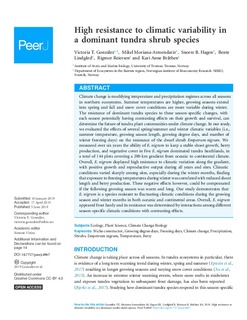High resistance to climatic variability in a dominant tundra shrub species
| dc.contributor.author | Gonzalez, Victoria | |
| dc.contributor.author | Moriana Armendariz, Mikel | |
| dc.contributor.author | Hagen, Snorre | |
| dc.contributor.author | Lindgård, Bente | |
| dc.contributor.author | Reiersen, Rigmor | |
| dc.contributor.author | Bråthen, Kari Anne | |
| dc.date.accessioned | 2020-01-03T09:58:01Z | |
| dc.date.available | 2020-01-03T09:58:01Z | |
| dc.date.created | 2019-12-06T16:34:36Z | |
| dc.date.issued | 2019-06-05 | |
| dc.identifier.citation | PeerJ. 2019, 7 . | nb_NO |
| dc.identifier.issn | 2167-8359 | |
| dc.identifier.uri | http://hdl.handle.net/11250/2634734 | |
| dc.description.abstract | Climate change is modifying temperature and precipitation regimes across all seasons in northern ecosystems. Summer temperatures are higher, growing seasons extend into spring and fall and snow cover conditions are more variable during winter. The resistance of dominant tundra species to these season-specific changes, with each season potentially having contrasting effects on their growth and survival, can determine the future of tundra plant communities under climate change. In our study, we evaluated the effects of several spring/summer and winter climatic variables (i.e., summer temperature, growing season length, growing degree days, and number of winter freezing days) on the resistance of the dwarf shrub Empetrum nigrum. We measured over six years the ability of E. nigrum to keep a stable shoot growth, berry production, and vegetative cover in five E. nigrum dominated tundra heathlands, in a total of 144 plots covering a 200-km gradient from oceanic to continental climate. Overall, E. nigrum displayed high resistance to climatic variation along the gradient, with positive growth and reproductive output during all years and sites. Climatic conditions varied sharply among sites, especially during the winter months, finding that exposure to freezing temperatures during winter was correlated with reduced shoot length and berry production. These negative effects however, could be compensated if the following growing season was warm and long. Our study demonstrates that E. nigrum is a species resistant to fluctuating climatic conditions during the growing season and winter months in both oceanic and continental areas. Overall, E. nigrum appeared frost hardy and its resistance was determined by interactions among different season-specific climatic conditions with contrasting effects. | nb_NO |
| dc.language.iso | eng | nb_NO |
| dc.rights | Navngivelse 4.0 Internasjonal | * |
| dc.rights.uri | http://creativecommons.org/licenses/by/4.0/deed.no | * |
| dc.subject | Niche constructor | nb_NO |
| dc.subject | Growing degree days | nb_NO |
| dc.subject | Freezing days | nb_NO |
| dc.subject | Climate change | nb_NO |
| dc.subject | Precipitation | nb_NO |
| dc.subject | Shrubs | nb_NO |
| dc.subject | Empetrum nigrum | nb_NO |
| dc.subject | Temperature | nb_NO |
| dc.subject | Berry | nb_NO |
| dc.title | High resistance to climatic variability in a dominant tundra shrub species | nb_NO |
| dc.type | Journal article | nb_NO |
| dc.type | Peer reviewed | nb_NO |
| dc.description.version | publishedVersion | nb_NO |
| dc.rights.holder | Copyright 2019 González et al. | nb_NO |
| dc.subject.nsi | VDP::Landbruks- og Fiskerifag: 900 | nb_NO |
| dc.source.pagenumber | 19 | nb_NO |
| dc.source.volume | 7 | nb_NO |
| dc.source.journal | PeerJ | nb_NO |
| dc.identifier.doi | 10.7717/peerj.6967 | |
| dc.identifier.cristin | 1757756 | |
| cristin.unitcode | 7677,4,0,0 | |
| cristin.unitname | Divisjon for miljø og naturressurser | |
| cristin.ispublished | true | |
| cristin.fulltext | original | |
| cristin.qualitycode | 1 |
Files in this item
This item appears in the following Collection(s)
-
Divisjon for miljø og naturressurser [756]
Publikasjoner knyttet til ansatte ved Divisjon for miljø og naturressurser -
Publikasjoner fra CRIStin - NIBIO [4576]
-
Vitenskapelige artikler [1416]

